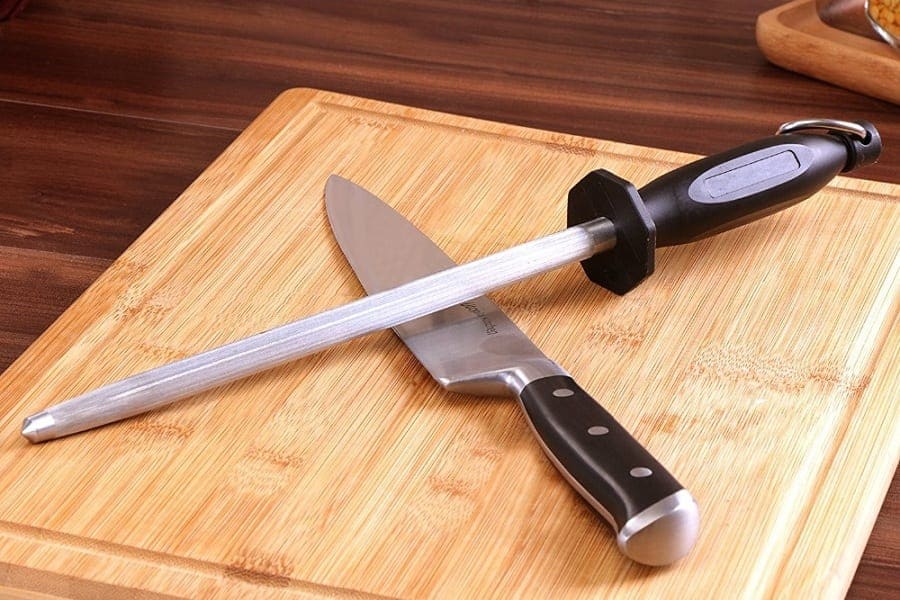Ceramic knives are known for their sharpness, but what happens when they go dull?
If the question you are asking today is how do you sharpen ceramic knives, then you have come to the right place.
Ceramic knives are in a league of their own. They have some of the best qualities for the kitchen, such as their sharpness and light weight. However, that does not erase their downsides.
A major drawback of the ceramic knife is how hard they are to sharpen.
Fortunately, this guide will explain how to sharpen ceramic knives in three easy steps.
We will also cover why ceramic knives go dull, what makes them different from steel knives, and will throw in some last-minute tips and tricks.
Let’s get started.
Why Do Ceramic Knives Go Dull?
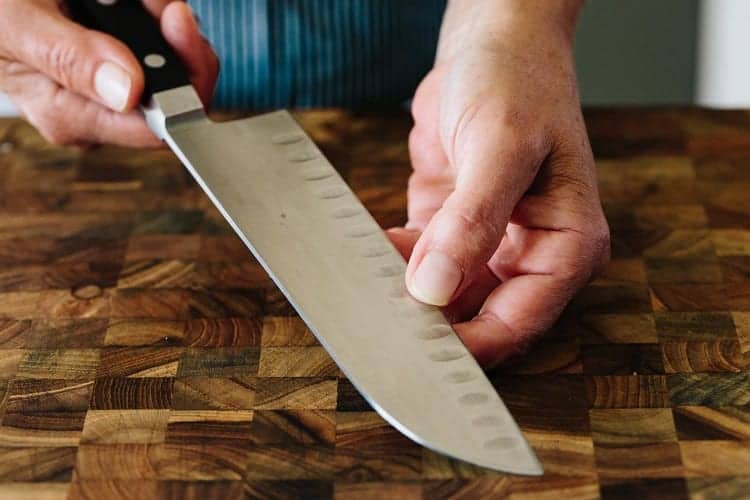
There is a popular notion that ceramic knives never go dull. Unfortunately, this is only a false notion that the marketing world has convinced you of.
The true fact about ceramic knives is that they take a long time to dull. However, it is possible for them to lose their sharpness, like any other knife.
You are probably asking the question, “how do you sharpen ceramic knives” because your knives are not performing as well anymore.
There are a few factors that might have contributed to your dull knives.
Poor Storage
The main reason why any knife will go dull is improper storage. A surprising amount of people will throw their kitchen knives into a drawer amongst other utensils.
Doing this will increase the likelihood of nicks, dents, and damage to the blade. If you do not store ceramic knives in a block, they will dull more quickly.
Improper Maintenance
Ceramic knives are very different than normal knives (we will explain why later). For this reason, there are certain things you should and should not do with the knife.
- Don’t put the knives in the dishwasher. You will need to handwash them with soap and water.
- Use a plastic or wood cutting board. Do not use glass, stone, or bamboo cutting boards with ceramic knives.
- Use the knives for softer foods such as fruits, poultry, and vegetables. Avoid cutting any frozen foods.
- Do not use the blade on its side. Doing this could cause the blade to snap.
Regular Use of the Knife
Even when you follow all of the proper storage and maintenance techniques, your knife will eventually go dull. Every knife does.
If you use the knife regularly, every day, your ceramic knife will dull. However, if you take good care of the knife, it will take a while to dull.
When you start to notice the tool losing its sharpness, you should start sharpening the knife regularly. Don’t worry; regularly sharping the knife does not mean every day.
You will be fine if you do this every few months or even every six months.
What Makes Ceramic Knives Different?
There are a few things that make ceramic knives different from other knives.
Ceramic Knives Are Harder Than Carbon Steel and Stainless Steel Knives

Unlike other knives, ceramic knives are made with a certain kind of ceramic material known as zirconium dioxide.
This mineral is what contributes to the increased hardness of the knife. Compared to carbon steel and stainless steel knives, ceramic knives earn first place in the hardness level.
Many people love the knives due to this quality, but also because they will not rust.
Despite Their Hardness, Ceramic Knives Are Very Brittle
One of the major downsides of ceramic knives is that they are brittle. They can chip easily depending on how you store them and what foods you cut with the knife.
If you drop the knife, you will most likely need to buy a new one.
They Are Sharper Than Other Kitchen Knives

Even with their main downside, people still use knives since they are so sharp. The knives are sharper than other kitchen knives and make cutting certain foods much easier and faster.
Furthermore, if you store them properly and take care of them, they will last for a long time, which is another plus. They usually take a while to dull.
Ceramic Knives Are the Hardest To Sharpen
One of the most notable issues with ceramic knives is that they are difficult to sharpen.
There are two reasons why they are hard to sharpen. First of all, you cannot use any old knife sharpener with these tools. If you use the same sharpener you use for carbon steel knives, it will take a long time before you get any results, if any.
To sharpen the knife effectively, you need to purchase a certain product: a diamond knife sharpener.
Furthermore, since the knives are so brittle, you have to be extremely careful during the sharpening process. Technique is key with ceramic knife sharpening. Beginners will often accidentally break the blade by applying too much pressure.
Step-by-Step Guide for Sharpening Ceramic Knives
As we have covered, sharpening ceramic knives is no easy feat. However, there are still ways to get the job done. Let’s take a look.
Step One: Use a Diamond Knife Sharpener
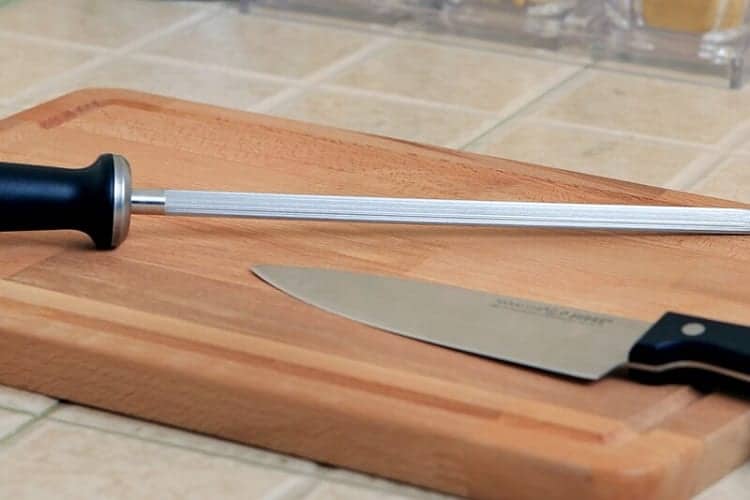
How do you sharpen ceramic knives? Well, first, you have to start with the right tool.
You may be tempted to go to the store and buy a regular knife sharpener. If you do this, be prepared for a lot of work and a lot of frustration.
Ceramic blades are very hard and are similar to the consistency of diamonds. The absolute best option to sharpen the blades with will be with diamond.
Using any other kind of sharpener will take much longer and might not even work.
Here are a few kinds of diamond knife sharpeners you can use.
- V-edge sharpener
- Diamond stones
- Ceramic rods
Step Two: Distribute the Weight Evenly While Sharpening
The last thing you want to do is apply too much pressure to one area of the knife. For instance, if you are only holding the knife with one hand by the handle, all of the pressure will be near the top of the blade.
If you are using a v-edge sharpener or ceramic rods, there will only be so much you can do. Just make sure not to apply too much pressure to one area of the blade.
However, when you use diamond stones, you will have more control. There is a specific way to hold the knife when using this tool.
Use both hands and place multiple fingers on the blade’s flat side, distributing the pressure as much as possible. Then you can start to sharpen the knife. Yes, this will feel odd, but it is the best way to do it.
Step Three: Sharpen the Knife in a Light and Smooth Motion
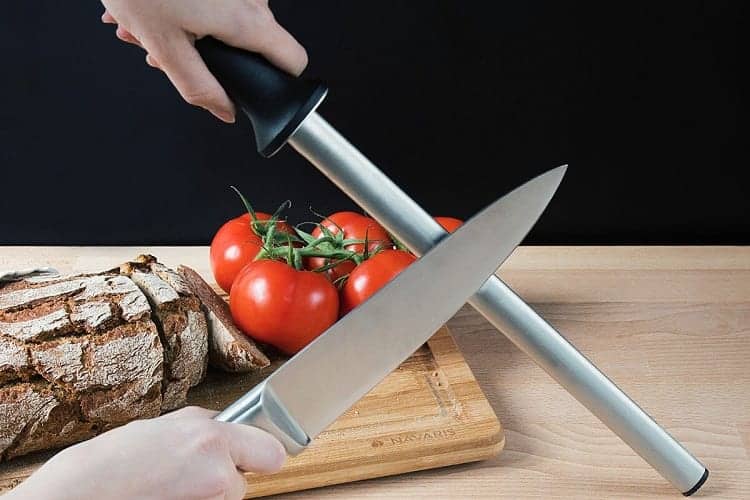
Now that you have placed your fingers in the correct position, it is time to sharpen. Again, you will need to be mindful of the weight of your hands.
You will need to sharpen the knife with light, smooth motions. The knife won’t become sharper the harder you press. Sharpening at a lighter pressure will have the same effect.
Feel free to use up or down strokes during the process. The direction will not make a difference either.
Extra Tips
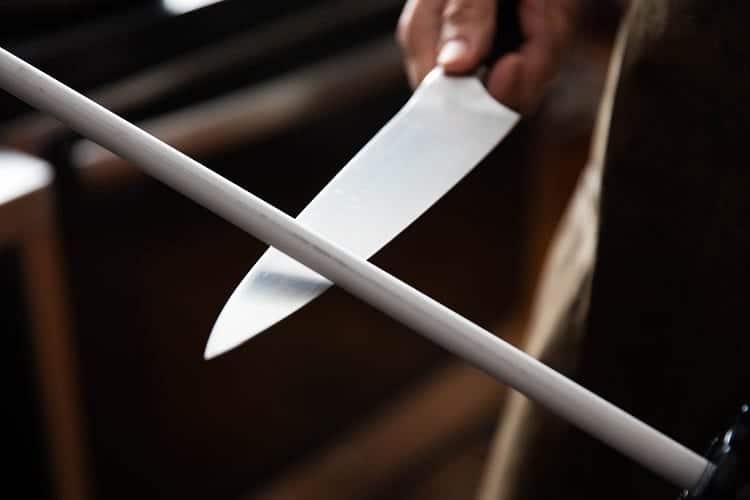
Now that we have answered the question “how do you sharpen ceramic knives,” it’s time to look at a few extra tips and tricks.
Never put too much pressure on the blade
Since ceramic blades are so brittle, you have to be very careful when sharpening them. If you put too much pressure on the blade, it could snap in half.
Be mindful of the dangers
As we have covered, there is a decent risk of the ceramic blade breaking. For that reason, you need to be prepared if that happens.
When sharpening, consider wearing safety goggles, closed-toe shoes, and gloves. (Make sure no pets are running around either – I’m sure they won’t like a knife-piece landing on them.)
Use diamond stone if you are sharpening a damaged knife
It will be quite difficult to sharpen a damaged knife with ceramic rods or a v-edge sharpener. When using those sharpeners, it is very easy to accidentally apply too much pressure to one area of the knife.
An already damaged blade will be weaker, and therefore more prone to breaking.
Conclusion
Sharpening ceramic knives can be a tricky task. However, with the right tools and techniques, you shouldn’t have a problem.
Make sure to use a diamond knife sharpener. Anything else will not give good results. You can use a diamond stone or V-edge sharpener or ceramic rods to do the job.
When sharpening, the most important thing to remember is to apply even pressure. Do not press too hard or use fast strokes; this could result in a broken blade.
After you have successfully sharpened the knife, make sure to store and maintain the knife properly to prevent the knife from going dull.
Keep the knife in a block and avoid throwing it in a drawer. Only use softwood or plastic cutting boards and never cut frozen fruit with it.
Resources:

